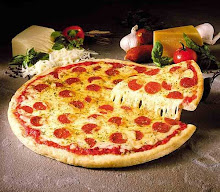I recently began my search for the best pizza in San Diego a few months ago in July and decided to record my investigations in a blog (The San Diego Pizza Investigation). I picked up the Thursday Food section of The Union Tribune and, to my delight, they were running an article on Pizza. They mentioned that baker and author of the successful book The Baker's Apprentice, Peter Reinhart, recently came out with a new book called American Pie: My Search for the Perfect Pizza. When I read that, I knew if I was to be a self respecting pizza investigator, then I had to read about Reinhart's search. I hoped it would aid in my pizza search, and I was not mistaken. American Pie is a great story about a man's search, not just around America, but around the world finding what it takes to make a great pie, and it also provides indispensable information for any person concerned about pizza making, pizza ingredients and a healthy fix of pizza history.
Reinhart is driven by a question: when he says that Pizzeria Bianca in Arizona is the best pizza he has ever tasted can he really be sure that there's nothing better? He begins his search in, where else, Italy. He moves along from Genoa to Rome to Naples and many places in between. From there he travels back to the States and searches New York, New Haven, San Francisco and Los Angeles. There are a variety of different styles of pizza and focaccia that he encounters, and he also recognizes some important generalizations about what it takes to make a great pizza.
I think the most profound observation in this book is when Reinhart reveals that what makes a great pizza is not the great ingredients or the fantastic oven; great pizza is made from dedicated pizzaiolis, pizza makers. This point, I thought, was profound considering it is one of the numerous metaphors found in cooking that reflects life in general. It may be necessary for the pizzaioli to be somewhat talented and have access to great ingredients, but these are not sufficient for creating wonderful pizza. The pizzaioli must be dedicated to his craft and sincerely care to make the best pizza posible. This drive alone, while being something that only comes from within a pizzaioli, is the seed to acquiring all the rest of the external necessities of a great pie. Throughout his search, Reinhart finds this truth to be evident regardless of geographic location or pizza style.
I appreciated how Reinhart organized the different styles of pizza. In Italy he distinguished between varieties of foccacia and noted the differences between the Roman style pizza, with it's almost cracker thin pizza bread, with that of the Nepoletana pizza of Naples, which is a little thicker but still light enough for a pizza to be a meal for one. The most useful distinction he makes is the 3 generations of Neo-Neopolitan pizza found in America. The first generation being the classic American pizza found in New York and New Haven. He calls the style in New Haven, Neo-Neopolitan, and the style in New York, simply enough, New York Style. Both styles, however would fit into the first generation. The second generation are the national pizza chains, like Pizza Hut, Domino's and Papa John's, that have become the most popular style. These pizzas, for better or worse, have developed into their own style. The third generation Neo-Neopolitan style in America is coined as California style. This style places emphasis on elaborate toppings. Reinhart gives Spago and California Pizza Kitchen the majority of credit or the development of this style. California style, however, is not without its critics. The more traditional pizza-lovers may may see the emphasis on toppings as missing the point to pizza: that pizza is essentially bread with a little something on top. These stylistic distinctions are not cut-and-dry. Reinhart himself seems to place New York Style pizza earlier in the book into the first generation and later in The Pizzas section place it in the second generation.
American Pie offers an interesting search around Italy and America for a great pizza, along with a helpful technical and linguistic introduction to dough making, cheeses, Italian pizza terminology and creating particular pizza styles. For each style, Reinhart offers some of his own recipes and recommendations for one's own variations. This book is a worthwhile read for anyone who loves all things pizza.
A Baker's Quest for Great Pizza
Labels: Book Review
Subscribe to:
Post Comments (Atom)

0 comments:
Post a Comment